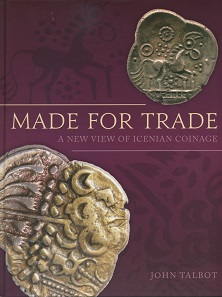by Ursula Kampmann
translated by Christina Schlögl
January 25, 2018 – You will only find a small number of articles on Celtic coins in CoinsWeekly. This is not due to a lack of interest, but because I cannot think of anything substantial to write about the topic. However, considering the Iceni tribe at least, this has dramatically changed after I read John Talbots inspiring book.
John Talbot, Made for trade. A new view of Icenian coinage. Oxbow, Oxford/Philadelpia 2017. 254 p. with illustrations in black and white and colour, 22.2 x 28.8 cm. Hardcover, ISBN: 9781785708121. GBP 55.
The Iceni were a Celtic tribe that mainly lived in the areas of today’s Norfolk, Suffolk and Cambridgeshire. Many enthusiasts for English history know them a bit better than other tribes, because of the widow of the Icenian king Prasutagus, who was allied with the Romans. After his death, his widowed wife Boudica stated a famous uprising.
Due to the exemplary work of the Portable Antiquities Scheme, we know the coin types that were predominantly found on Icenian territory. John Talbot has spent more than a decade studying their culture and he published his interim result in many articles. He has split the material and distributed it to three different mints and sorted them chronologically. He looks for the reasons and models that could have lead to the Iceni’s own coinage. Next, Talbot describes, classifies and dates the coin types he has defined in great detail. His deliberations are illustrated by maps and carefully chosen, well-preserved coins. And of course he also interprets the hoards and smaller discoveries the Icenian coins came from.
Relying on the comprehensive die study that serves as the foundation of Talbot’s research, the author takes a new line. Forget everything you know about die studies of ancient coins! Talbot does not provide an extensive catalogue featuring all known coins, listed according to numismatic criteria. Instead he offers a photographic summary on 53 plates. This visual summary can be comprehended very intuitively and it is probably a better illustration of the material than a listing of randomly preserved coins and information on larger or smaller emissions.
It is not surprising that a British publication of all things has chosen such an innovative way of presenting a die study. Thanks to the Portable Antiquities Scheme, our colleagues in Great Britain are surrounded by so much material – Talbot examined more than 10,000 (!) coins for his study – and easily accessible photos that they don’t get caught up in single specimens but instead try to get a general view. And Talbot has truly succeeded in creating such a general view in his die study.
John Talbot only starts where other books would already end. He examines the material and tries to see if it constitutes a fixed monetary system, i.e. if the alloy of the coins is consistent and if the weights of the coins are connected in a way that is easily comprehensible. He discusses the effigies and proofs that, after a phase of wild experimentation, a kind of standardisation of images slowly appears. This hints at a mass production of the coins.
The climax of his book is its last chapter, which he modestly calls ‘Conclusions’. It is nothing less than an attempt to open up a new perspective on the Icenian coinage. He asks why the Iceni minted coins and which political authorities issued them. In other words: Did merchants give the order to mint coins from metal? Or do we have to assume that a king (or queen) was giving the orders to mint coins? The Icenian coinage ended with Boudica’s uprising, after all.
We cannot find definitive answers in John Talbot’s book about the coins of the Iceni. We can find much more. He reformulates the questions about the Celtic tribes we will one day be able to answer using their coinage. His book is much more than just another catalogue to classify coins. (Although it also serves as a catalogue. It is a new standard work that coin dealers will have to cite in the future!) ‘Made for Trade – A New View of Icenian Coinage’ is a thought-provoking impulse, advancing to the core of economic history: Which role did coins play during economic transactions and what was the social background of these coins?
You can order John Talbot’s book here. It is available on special sale at Oxbox at the moment.




